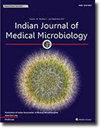Evaluation of BD Phoenix and VITEK 2 for direct and routine antimicrobial susceptibility from positive blood culture bottles
IF 1.4
4区 医学
Q4 IMMUNOLOGY
引用次数: 0
Abstract
Objectives
This study aims to comparatively evaluate the reliability of BD Phoenix and VITEK 2 systems for direct, routine and standard antimicrobial susceptibility testing (AST) of ESKAPE isolates from positive blood culture bottles, with a primary focus on the interpretation of results into susceptible, intermediate, or resistant categories.
Methods
A total of 128 ESKAPE isolates from positive blood culture bottles were subjected to direct, routine and standard AST. Direct AST (DAST) and routine AST (RAST) were performed using BD Phoenix and VITEK 2 automated systems. DAST was conducted using a bacterial pellet obtained directly from positive blood cultures, while RAST used a colony after subculture. Results of both were compared based on categorical agreement (CA) and discrepancies. RAST results were further evaluated against standard AST (SAST), performed via the Kirby-Bauer disc diffusion assay using 24 h-grown colonies.
Findings and results
The AST categorical agreements (CA) of DAST with the RAST using BD Phoenix automated system for Enterobacterales, Non-fermenting, and Gram-positive cocci (S. aureus and Enterococci spp.) were 95.3 %, 100 %, and 100 % respectively, while 94.8 %, 94.7 %, 80 % and 100 % respectively in VITEK 2.
CA between RAST and SAST is 86.9 %, 95.3 %, 100 %, and 82.3 % respectively with BD Phoenix, while 91.8 %, 91.9 %, 85.7 %, and 84.6 % respectively with VITEK 2, on the same group of bacteria. The VITEK 2 automated system showed consistency of results with >90 % CA suggesting high reliability for both direct and routine AST in Gram-negative bacteria.
Conclusion
VITEK 2 demonstrated consistently high reliability for both direct and routine AST in Gram-negative bacteria. The BD phoenix showed high reliability for direct AST only, across all organisms tested. Direct AST protocol established in this study is simple, cost-effective, reliable, and rapid techniques reducing turnaround time (TAT) by 24 h and potentially improving patient's outcome.
BD Phoenix和VITEK-2对阳性血培养瓶直接和常规抗菌药物敏感性的评价。
目的:本研究旨在比较评估BD Phoenix和VITEK 2系统对阳性血培养瓶中ESKAPE分离株进行直接、常规和标准药敏试验(AST)的可靠性,主要关注将结果解释为敏感、中间或耐药类别。方法:对128株ESKAPE阳性血培养瓶进行直接AST、常规AST和标准AST检测,直接AST (DAST)和常规AST (RAST)分别采用BD Phoenix和VITEK 2自动化系统进行检测。DAST使用直接从阳性血液培养中获得的细菌颗粒进行,而RAST使用传代培养后的菌落进行。根据分类一致(CA)和差异对两者的结果进行比较。RAST结果进一步与标准AST (SAST)进行评估,通过Kirby-Bauer圆盘扩散试验,使用生长24小时的菌落。结果:采用BD Phoenix自动检测系统对肠杆菌、非发酵菌和革兰氏阳性球菌(金黄色葡萄球菌和肠球菌)的AST分类一致性(CA)分别为95.3%、100%和100%,而VITEK 2的DAST分类一致性分别为94.8%、94.7%、80%和100%。在同一组细菌上,BD Phoenix与SAST的CA分别为86.9%、95.3%、100%和82.3%,VITEK 2的CA分别为91.8%、91.9%、85.7%和84.6%。VITEK 2自动化系统显示结果的一致性为>90% CA,表明在革兰氏阴性菌中直接和常规AST的高可靠性。结论:VITEK 2在革兰氏阴性菌的直接和常规AST检测中均表现出一贯的高可靠性。在所有测试的生物中,BD凤凰仅对直接AST显示出高可靠性。本研究建立的直接AST协议是一种简单、经济、可靠和快速的技术,可将周转时间(TAT)缩短24小时。并且有可能改善病人的治疗效果。
本文章由计算机程序翻译,如有差异,请以英文原文为准。
求助全文
约1分钟内获得全文
求助全文
来源期刊

Indian Journal of Medical Microbiology
IMMUNOLOGY-
CiteScore
2.20
自引率
0.00%
发文量
154
审稿时长
73 days
期刊介绍:
Manuscripts of high standard in the form of original research, multicentric studies, meta analysis, are accepted. Current reports can be submitted as brief communications. Case reports must include review of current literature, clinical details, outcome and follow up. Letters to the editor must be a comment on or pertain to a manuscript already published in the IJMM or in relation to preliminary communication of a larger study.
Review articles, Special Articles or Guest Editorials are accepted on invitation.
 求助内容:
求助内容: 应助结果提醒方式:
应助结果提醒方式:


